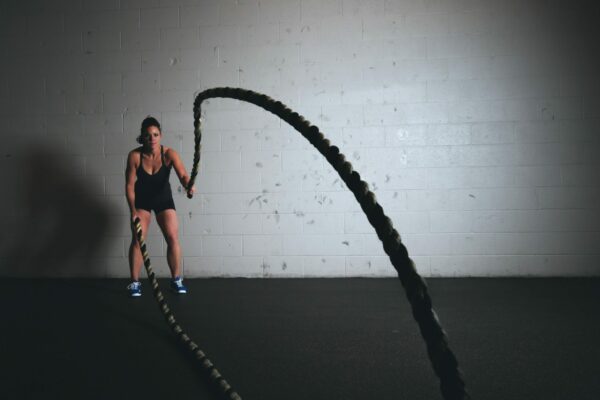This post is a little guide with the 6 Best ways for training to a half marathon with success – how to prepare yourself in the best way. An important aspect that is often overlooked is about being able to reflect on goal setting and training. Many of us simply start with a training program that is not tailored to our personal capacity. Knowing these factors in advance will make it easier to move towards the goal.

Half Marathon Training Plan
When you start training for a half-marathon, it is important that you have a plan and set aside time to train at least 3 times a week. The training is performed with variation, so you alternate between low-intensity training and high-intensity training. In this way, you also reduce the risk of injuries.
You should plan your training, so you run the long runs at an easy to moderate pace, also called endurance training, corresponding to an intensity of 60-70% of your max. heart rate.
In this way, the body slowly gets used to working for a longer period. To improve your shape and performance, you should also have higher-intensity training sessions. Running with higher intensity performs by using interval training. As you will experience, interval training has many positive impacts on both performance and your overall health profile.
Interval Training
By Interval training, there is an alternation with breaks and work periods. Since there are breaks, you can run at a higher pace (intensity) during the work period. Interval training can be performed as Hill training, strides, pyramid training etc.

Thus, there are many ways to train intervals and which ones are the best depends on the purpose of the training. You should be careful not to fall into the intensity trap, which means that it is important to train in a way where you ensure to balance the right intensity corresponding to 80-100% of your max. heart rate with the rest of the training in the period up to the race day. Hereby you avoid overtraining or getting injuries.
A particularly good and effective interval training session is the 10-20-30 method. This method has been scientifically tested showing both an increase in performance and health profile. The method is, that you run 30 seconds at a low pace, then run 20 seconds at a moderate pace, and finally run 10 seconds sprint / high pace.
This will take you one minute and is repeated 5 times before pausing for 2 minutes. Start by repeating 2-3 times and increase up to 5 repetitions. You must warm up before you start on the intervals since it is a demanding training form.
Half Marathon Training Schedule
Finding the right training schedule that fits you can be a challenge. You can get more ‘freedom’ to put together your own training schedule with the right intensity all the way to the goal by using this link here. This post explains how to develop a personal training program a basic program for marathon training and it’s a good place to start also for a half-marathon as a beginner.
You should start by finding your level and taking it from there.
There are also schedules on the web like on Hal Higdon’s website. The problem is just that they are often not adapted exactly to your running capacity and level but are a kind of standard programs until you have found out what works best for you. A good start could be building up your experience bank when training for a half marathon.
However, you must find a schedule that suits you and your requirements, and at the same time also remember that it is better for your health profile to run a few longer runs at a low intensity and several shorter runs at a high intensity than many long runs at moderate intensity.
As a rule of thumb, we can say that if you are an easily trained runner, and can run 5 km without problems, then you should expect to use 10-12 weeks of training to complete a half-marathon.
Cross Training Workouts
Running can become a one-sided affair over time when you follow a training program only with running. The body is not developed for repeated one-sided, monotonous work for prolonged periods.
So, we need to vary the training as much as possible. Running training can be performed in a way that gives a significant variation within the race itself in terms of pace. But you can also perform a part of your training as cross training workouts in a fitness center or at home.
Also, cycling or swimming provides variety and improves fitness. By finding cross training activities you develop other muscle groups – ‘support’ muscles for running training. Ex. I use the cross trainer with great benefits in the fitness center.
Strength training should also be an important part of your training if you want to prepare your performance and prevent injuries. Strength training leads to improved elasticity and energy utilization in the muscle tendons, which improve your running economy. You can perform strength training in many ways.

Strength training for runners
There are two types of strength training for runners in particular that have been shown to have a good effect on the running economy and thus running performance: weight training with relatively heavy load and plyometric strength training (explosive jumping training). Common to both types of strength training is that the exercises are predominantly centered around functional training for the whole body.
It is a good idea to prioritize functional whole-body exercises over isolated exercises, i.e., use fitness machines that train the major muscle groups at the same time Instead of training e.g., specific exercises for biceps only.
You achieve greater functionality of ‘whole body exercises’ while these types of exercises are more conducive to running economy and your overall body strength, which is crucial to how you move when you run.
It is a myth that strength training will make you slow and heavy. This is not true, as it has been proven that strength training optimizes running performance by improving the running economy.
Half Marathon Training
I have written about the Periodization of running training in one of my previous posts, which is important, as you, with this time frame, divide your training into small and manageable periods for which you can set yourself motivating milestone goals.
You should slowly build up your training in a preparation period of approx. 10-12 weeks before the race depending on your current running status. During this period, your total amount of training should gradually increase, intensity and frequency should increase as well.
Then you get into what we call the Tapering period. Here, the body must be made completely ready for race day, and you should therefore reduce your total amount of training, but still maintain the intensity high in your training, so your shape curve does not start to decrease.

Throughout your training period is recovery very important. Physical exercise has a debilitating effect on the body, but the body can rebuild itself and adapt to the new physical demands, this phenomenon is called super compensation. It can only be done if you give it peace and rest between your training sessions.
Thus, it is not the training itself that makes you better. In fact, it is during the break between your training sessions that the improvement happens – when the body rebuilds itself to a stronger version.
Long Distance Running Technique
Running is not just putting one leg in front of the other, but it is not much harder than that. By keeping in mind, the good tips below, you will get an easier, faster, and more gentle running technique, since a better running technique gives you:
- Better running style
- Fewer injuries
- Less soreness
- Higher speed
- More efficient running
To improve your running technique, you can train different aspects of running such as:
Trail training
Running in uneven terrains like in hilly forests with roots, rocks, and mud is great training for the running technique. The challenging and often slippery surface will automatically force you to tense up more in the core muscles and run with shorter steps.
You can challenge yourself on the technical, uneven passages, but be aware of being in control, so you do not wiggle the foot and get an injury.
Training variation
If you only run at one particular pace each time you run, your body and your entire movement pattern will develop and adapt to that pace. Therefore, make sure to vary your pace over the week and run both short runs, fast sprints and long easy runs. It will also benefit your fitness and your endurance.
Weight training for runners
Poor running style is often associated with weak muscles in the abdomen, back, hips and buttocks. Strengthen them with good exercises for the whole body such as lunges, squats and deadlifts. Also, strengthen your upper body with exercises like pull-ups and push like bench press. Strength training 2 times a week would be fine.

Tests Before The Half Marathon Race Day
You should also use your training to get to know your body. What works e.g., best for you when it comes to fluid and food intake along the way? You mustn’t try various energy products such as gels and dried fruits for the first time, on the race day!

You never know with adequate certainty how your stomach will react to it, and it would be a shame to quit the race due to stomach problems after many weeks of intensive training. Also remember that if it is very hot on race day, then you need more water. Drink abundantly but not excessively; as a rule of thumb, remember to drink at each fluid depot or for every approx. 5-6 km.
Also, make sure that you test your shoes and clothes during your training sessions. It is never a good idea to run in new shoes or new clothes on race day. It is important that your shoes are adapted without being too old and worn out, and that your shoes fit your running style and running technique.
In this way, you know what works best for you and can therefore better avoid injuries, blisters and scratch marks. Physical strength will get you to the start line. But mental strength will get you to the finish line.
I hope you find this post useful and if you have any questions about the topic or want to leave your own personal review, please leave a comment below.
[faq-schema id=”4431″]






Marathons are definitely a sport that requires months of training and preparation. I used to sprint for my school and when I switched to another school in a new country, I ran my first relay race in blazing sun and collapsed towards the end. Sprinting and relay races running are two different things. And marathons are definitely a step up from those.
I later found out I suffered from sickle cell trait and that people who over-exert themselves and have the trait, can show signs of the full-blown anaemia. I have always walked fast and now have slowed down as I have grown older. However, with the help of exercise like Bikram Yoga, I hope to get my stamina and knees back to the strength they had when I was younger.
Thanks for sharing and making me think!
Hi Stella
Thank you for the comment, and the story. Happy that the post makes you think. The difference between an ex. 5k and a half marathon- or marathon is the timeline. For all distances, it’s about starting out slowly and from your current conditions.
Be Well
Thank you for your in-depth article on marathon training. Although I am not a runner, I can see the value in following the steps. I can also see how one can become very disciplined which can also be a benefit in other areas of one’s life.
With regards to running technique, I had no idea it was so important. Running is definitely work so I am going to stick to my speed walking :).
Hi Mary Ann
Thank you for the comment. Running is a great opportunity in many ways as you have seen. Speed walking is also an exercise form that brings many good experiences.
Be Well